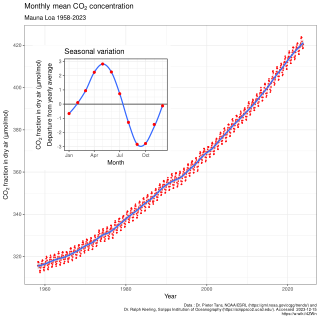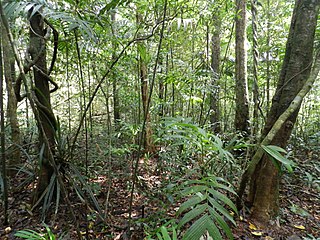Related Research Articles

Deforestation or forest clearance is the removal of a forest or stand of trees from land that is then converted to non-forest use. Deforestation can involve conversion of forest land to farms, ranches, or urban use. The most concentrated deforestation occurs in tropical rainforests. About 31% of Earth's land surface is covered by forests at present. This is one-third less than the forest cover before the expansion of agriculture, with half of that loss occurring in the last century. Between 15 million to 18 million hectares of forest, an area the size of Bangladesh, are destroyed every year. On average 2,400 trees are cut down each minute.

Glenn Theodore Seaborg was an American chemist whose involvement in the synthesis, discovery and investigation of ten transuranium elements earned him a share of the 1951 Nobel Prize in Chemistry. His work in this area also led to his development of the actinide concept and the arrangement of the actinide series in the periodic table of the elements.
The PaleozoicEra is the first of three geological eras of the Phanerozoic Eon. Beginning 538.8 million years ago (Ma), it succeeds the Neoproterozoic and ends 251.9 Ma at the start of the Mesozoic Era. The Paleozoic is subdivided into six geologic periods :
The Phanerozoic is the current and the latest of the four geologic eons in the Earth's geologic time scale, covering the time period from 538.8 million years ago to the present. It is the eon during which abundant animal and plant life has proliferated, diversified and colonized various niches on the Earth's surface, beginning with the Cambrian period when animals first developed hard shells that can be clearly preserved in the fossil record. The time before the Phanerozoic, collectively called the Precambrian, is now divided into the Hadean, Archaean and Proterozoic eons.

The Amazon rainforest, also called Amazon jungle or Amazonia, is a moist broadleaf tropical rainforest in the Amazon biome that covers most of the Amazon basin of South America. This basin encompasses 7,000,000 km2 (2,700,000 sq mi), of which 5,500,000 km2 (2,100,000 sq mi) are covered by the rainforest. This region includes territory belonging to nine nations and 3,344 formally acknowledged indigenous territories.

Melvin Ellis Calvin was an American biochemist known for discovering the Calvin cycle along with Andrew Benson and James Bassham, for which he was awarded the 1961 Nobel Prize in Chemistry. He spent most of his five-decade career at the University of California, Berkeley.
Climate engineering is a term used for both carbon dioxide removal and solar radiation management, also called solar geoengineering, when applied at a planetary scale. However, they have very different geophysical characteristics which is why the Intergovernmental Panel on Climate Change no longer uses this overarching term. Carbon dioxide removal approaches are part of climate change mitigation. Solar geoengineering involves reflecting some sunlight back to space. All forms of geoengineering are not a standalone solution to climate change, but need to be coupled with other forms of climate change mitigation. Another approach to geoengineering is to increase the Earth's thermal emittance through passive radiative cooling.

The Keeling Curve is a graph of the accumulation of carbon dioxide in the Earth's atmosphere based on continuous measurements taken at the Mauna Loa Observatory on the island of Hawaii from 1958 to the present day. The curve is named for the scientist Charles David Keeling, who started the monitoring program and supervised it until his death in 2005.

Charles David Keeling was an American scientist whose recording of carbon dioxide at the Mauna Loa Observatory confirmed Svante Arrhenius's proposition (1896) of the possibility of anthropogenic contribution to the greenhouse effect and global warming, by documenting the steadily rising carbon dioxide levels. The Keeling Curve measures the progressive buildup of carbon dioxide, a greenhouse gas, in the atmosphere.

Roger Randall Dougan Revelle was a scientist and scholar who was instrumental in the formative years of the University of California, San Diego and was among the early scientists to study anthropogenic global warming, as well as the movement of Earth's tectonic plates. UC San Diego's first college is named Revelle College in his honor.

Building blocks for tropical rainforest conservation include ecotourism and rehabilitation. Reforestation and restoration are common practices in certain areas to try to increase tropical rainforest density. By communicating with the local people living in, and around, the rainforest, conservationists can learn more about what might allow them to best focus their efforts. Rainforests are globally important to sustainability and preservation of biodiversity. Although they may vary in location and inhabited species of plants and animals, they remain important worldwide for their abundance of natural resources and for the ecosystem services. It is important to take into consideration the differing species and the biodiversity that exists across different rainforest types in order to accurately implement methods of conservation.

Brazil once had the highest deforestation rate in the world and in 2005 still had the largest area of forest removed annually. Since 1970, over 700,000 square kilometres (270,000 sq mi) of the Amazon rainforest have been destroyed. In 2001, the Amazon was approximately 5,400,000 square kilometres (2,100,000 sq mi), which is only 87% of the Amazon's original size. According to official data, about 729,000 km² have already been deforested in the Amazon biome, which corresponds to 17% of the total. 300,000 km² have been deforested in the last 20 years.
This is a list of climate change topics.

Solar geoengineering, or solar radiation modification (SRM), is a type of climate engineering in which sunlight would be reflected back to outer space to limit or offset human-caused climate change. There are multiple potential approaches, with stratospheric aerosol injection (SAI) being the most-studied method, followed by marine cloud brightening (MCB). Other methods have been proposed, including a variety of space-based approaches, but they are generally considered less viable, and are not taken seriously by the Intergovernmental Panel on Climate Change. SRM methods could have a rapid cooling effect on atmospheric temperature, but if the intervention were to suddenly stop for any reason, the cooling would soon stop as well. It is estimated that the cooling impact from SAI would cease 1–3 years after the last aerosol injection, while the impact from marine cloud brightening would disappear in just 10 days. Contrastingly, once any carbon dioxide is added to the atmosphere and not removed, its warming impact does not decrease for a century, and some of it will persist for hundreds to thousands of years. As such, solar geoengineering is not a substitute for reducing greenhouse gas emissions but would act as a temporary measure to limit warming while emissions of greenhouse gases are reduced and carbon dioxide is removed.

Environmental issues are disruptions in the usual function of ecosystems. Further, these issues can be caused by humans or they can be natural. These issues are considered serious when the ecosystem cannot recover in the present situation, and catastrophic if the ecosystem is projected to certainly collapse.

The history of the scientific discovery of climate change began in the early 19th century when ice ages and other natural changes in paleoclimate were first suspected and the natural greenhouse effect was first identified. In the late 19th century, scientists first argued that human emissions of greenhouse gases could change Earth's energy balance and climate. The existence of the greenhouse effect, while not named as such, was proposed as early as 1824 by Joseph Fourier. The argument and the evidence were further strengthened by Claude Pouillet in 1827 and 1838. In 1856 Eunice Newton Foote demonstrated that the warming effect of the sun is greater for air with water vapour than for dry air, and the effect is even greater with carbon dioxide.

The World Resources Institute (WRI) is a global research non-profit organization established in 1982 with funding from the MacArthur Foundation under the leadership of James Gustave Speth. Subsequent presidents include Jonathan Lash, Andrew D. Steer and current president Ani Dasgupta (2021-).

Deforestation is a primary contributor to climate change, and climate change affects forests. Land use changes, especially in the form of deforestation, are the second largest anthropogenic source of atmospheric carbon dioxide emissions, after fossil fuel combustion. Greenhouse gases are emitted during combustion of forest biomass and decomposition of remaining plant material and soil carbon. Global models and national greenhouse gas inventories give similar results for deforestation emissions. As of 2019, deforestation is responsible for about 11% of global greenhouse gas emissions. Carbon emissions from tropical deforestation are accelerating. Growing forests are a carbon sink with additional potential to mitigate the effects of climate change. Some of the effects of climate change, such as more wildfires, insect outbreaks, invasive species, and storms are factors that increase deforestation.
References
- 1 2 Seaborg, David (December 1, 2019). "The life and contributions to the periodic table of Glenn T. Seaborg, the first person to have an element named after him while he was still alive". Pure and Applied Chemistry. 91 (12): 1929–1939. doi: 10.1515/pac-2019-0816 . ISSN 1365-3075. S2CID 208747513.
- ↑ "About Marquis". Marquis Whos Who History Timeline. Archived from the original on September 13, 2017. Retrieved April 27, 2022.
- ↑ "red-dipper-llc - About". red-dipper-llc.
- ↑ Seaborg, David (September 10, 2021). How Life Increases Biodiversity: An Autocatalytic Hypothesis. Boca Raton: CRC Press. doi:10.1201/9780429440137. ISBN 978-0-429-44013-7. S2CID 240834792.
- ↑ Seaborg, David M. (May 7, 1999). "Evolutionary Feedback: a New Mechanism for Stasis and Punctuated Evolutionary Change Based on Integration of the Organism". Journal of Theoretical Biology. 198 (1): 1–26. Bibcode:1999JThBi.198....1S. doi:10.1006/jtbi.1998.0896. ISSN 0022-5193. PMID 10329112.
- ↑ Seaborg, David M. (March 12, 1985). "Sexual Orientation, Behavioral Plasticity, and Evolution". Journal of Homosexuality. 10 (3–4): 153–158. doi:10.1300/J082v10n03_18. ISSN 0091-8369. PMID 6533173.
- 1 2 Seaborg, David (2004). "The greenhouse diet". Earth Island Journal. 18 (4): 39–41. ISSN 1041-0406. JSTOR 43879201.
- 1 2 "David Seaborg, Global Environmental Committee". Mount Diablo Peace and Justice Center. July 7, 2013. Retrieved April 27, 2022.
- ↑ De Jesus, Janice (November 24, 2009). "David Seaborg's book of poetry includes opinions on good poems, today's poetry". Contra Costa Times.